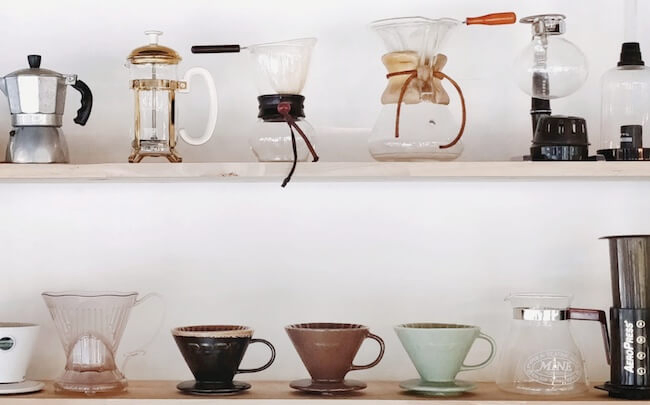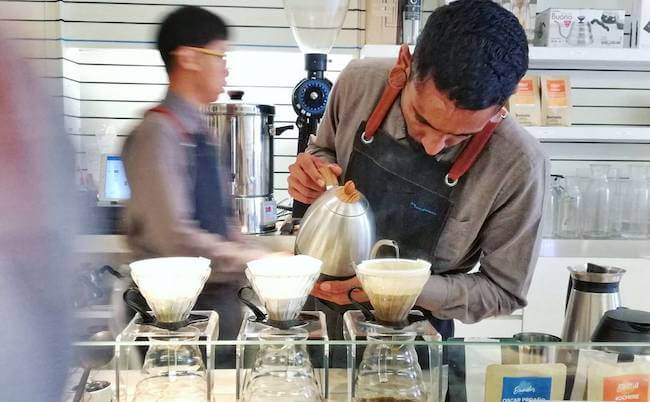I get it; coffee can be confusing. Back in the days, you only really had to think about whether you wanted it with sugar or milk, or just black, but recently more and more crazy concoctions have sprung up.
This is my attempt at making a list that covers all different types of coffee and whether you should try them or not.
Common Types of Black coffees
- Drip Coffee: This is the classic coffee from your childhood. It’s brewed with a drip coffee machine and a paper filter. You already know whether or not you like this coffee, so I’m not going to give you any advice here.
- Batch Brew: This is essentially the “professional version” of drip coffee. Usually it’s made with a larger and better coffee maker than what you have at home. Many specialty coffee shops have started to offer this type of coffee, which means that it’s often an excellent option if you want a delicious cup of coffee with no milk or sugar.
- Espresso: A tiny cup of coffee, usually around 1 oz, originating in Italy. Brewed on an espresso machine that can force hot water through a puck of finely ground coffee with at least 9 bars of pressure. Espresso has a layer of golden-brownish crema on top. This type of coffee is the foundation of many other coffee drinks.
- Americano: This type of coffee is an espresso diluted with hot water. Strength-wise it’s usually slightly stronger than drip coffee, and the flavor is often a bit more ‘roasty’ and intense.
- Pour Over: Similar to drip coffee, except it has been brewed manually by the barista. Often he or she will use a small pour over cone from a company such as Hario or Kalita and slowly add water with a gooseneck kettle. One of my favorite brew methods.
- Instant coffee: Pour hot water on freeze-dried coffee. Stir. Easy to make but usually not very tasty as a cheap type of coffee called ‘Robusta’ is mostly used.
Lesser known black coffees
- Ristretto: An espresso with only half as much water and an even finer grind size resulting in a super intense flavor.
- Doppio: Italian word for ‘double espresso.’
- Long Black: Australian expression for ‘Americano.’
- Siphon Coffee: Brewed using a glass device called a Siphon or vacuum brewing pot. It relies on vacuum to pull water through ground coffee. Mostly seen in specialty coffee shops like Blue Bottle. A nuanced, yet bold coffee brewing method.
- Aeropress: This kind of coffee is made by using something that looks like an oversized syringe. The brew method combines both immersion and infusion. By using air pressure, it forces the brewed coffee through a paper filter. Cup quality can be excellent; a cheap and easy way to make good coffee at home.
- Turkish Coffee: Finely ground coffee is boiled in a unique kettle with sugar and served unfiltered. Not only served in Turkey, but also in parts of Eastern Europe and the Middle East.
Milk-based coffees
- Cappuccino: One of the most common types of coffee. Consists of a double shot of espresso and equal parts of steamed milk and milk foam on top.
- Latte: A caffe latte (or just latte, as it’s usually called) is a long milk-based coffee drink originating in the US in the 80’s. It’s like a cappuccino, but it’s bigger in terms of volume and has less milk foam on the top. Often it’s served in a tall glass and decorated with latte art
- Cafe Au Lait: A French type of coffee. Essentially, it’s a caffe latte served in a cappuccino cup.
- Caffè Macchiato: This is essentially an espresso shot with a tiny bit of milk foam on top. It should consist of at least 80 percent black coffee.
- Latte Macchiato: The latte macchiato is confusing because it shares its name with the caffè macchiato and in fact, it’s entirely different. It’s a tall glass of steamed and foamy milk with an espresso shot drizzled out on top. For that reason, it’s milk-white in the bottom and more brownish on the head.
- Cortado: This is a milk-based drink originating in Cuba and Spain. It’s usually similar to a cappuccino but uses less milk, making it a more ‘masculine’ alternative to other milk-based coffees.
- Gibraltar: More or less the same as a Cortado, but served in a glass. Made famous by Blue Bottle coffee.
- Flat White: More or less just an Australian name for a caffe latte. It differs by usually being served in smaller, ceramic cup as opposed to the tall glass, and might have less milk foam.
- Mocha: A cappuccino where one espresso shot is exchanged in favor of hot chocolate.
- Espresso con Panna: Espresso with a generous serving of whipped cream on top.
- Affogato: More a dessert than a coffee drink. Usually, it’s just a little glass or bowl with a scoop of vanilla ice cream and a single shot of espresso.
- Bulletproof Coffee: Coffee blended with unsalted butter and a particular derivative of coconut oil called MCT oil. Due to its high caloric content, it’s meant to replace breakfast. Supposedly, it aids weight loss and improves cognition.
- Irish Coffee: A cocktail consisting of hot coffee mixed with whiskey and brown sugar. Topped off with whipped cream.
- Dalgona Coffee: A mix of instant coffee, sugar mixed and hot water whisked together to create “coffee mousse”. Then topped with cold milk.

Different kinds of Ice coffee
- Japanese Ice Coffee: This refers to a pour over coffee, where half of the water is substituted with ice cubes. Hence, the coffee is brewed directly on ice. Often very delicious.
- Ice Americano: An Ice americano refers to a double shot of espresso poured over a glass full of ice. A common way for cafés to serve iced coffee.
- Ice latte: Like a caffe latte, the concoction is just poured on top of a tall glass of ice. Will still retain milk foam on the top.
- Cold Brew: Refers to a type of coffee where cold water and ground coffee is allowed to steep for at least 24 hours. Because it’s not brewed with hot water, the flavor is very low in acidity.
- Cold Drip: This brewing method lets cold water drip over the ground coffee very slowly using a special contraption. This method extracts more flavor than cold brew but is still low in acid.
- Nitro Coffee: Has become very popular the last couple of years. It’s coffee ‘on tap’; coffee infused with nitrogen, which makes it bubbly like a draft beer. Can be delicious.
- Espresso Tonic: A common sight in recent years, this drink consists of an espresso shot (or sometimes concentrated black coffee) poured on top of tonic water. Served on ice and often garnished with a slice of lemon or a wig of rosemary.

List of Rare coffee types and beans
- Cascara: You could call this “coffee-tea.” It’s made from the husk and pulp of the coffee cherry, which is dried. It can be infused and consumed in a similar way to tea. It has a golden-red color and tastes sweet and fruity. Contains caffeine like regular coffee but in smaller amounts.
- Geisha: For the last ten years, this coffee has been the most expensive and hyped coffee variety in the world. The berry is typically elongated and has flavors of bergamot, jasmine, and peach. In 2018 a pound of the most expensive Geisha was sold for $803 per pound. The highest quality is found in Panama.
- Pacamara: This is another sought-after coffee varietal. Pacamara is sometimes compared to Geisha, even though it has an entirely different flavor. The bean is larger compared to other varieties, and this variety is typically associated with El Salvador.
- Liberica: Coffee has three parent species. Most specialty coffee comes from the Arabica family, while most beans used for instant coffee and other commercial types of coffee comes from the Robusta species. However, there is a third and scarce species called ‘Liberica.’ It’s mostly grown in the Philippines today and can grow up to 20 meters tall. The flavor has been described as ‘manly’ and nutty.
- Kopi Luwak: A particular way of processing coffee prevalent in Indonesia where the coffee cherry is eaten by a civet and then defecated. Made famous by the Hollywood movie ‘The Bucket List.’ Some people claim that this adds a unique flavor to the coffee but virtually all coffee experts agree that it’s bogus. Also, this kind of coffee is contributing to animal cruelty.
- Honey Processed Coffee: There is no honey involved in creating this coffee – instead, it refers to a processing method, where the depulped cherries are allowed to dry with the mucilage on. This layer can look and smell a bit like honey. Honey processed coffee can be found in many specialty coffee shops today. It typically has notes of peach and berries.

